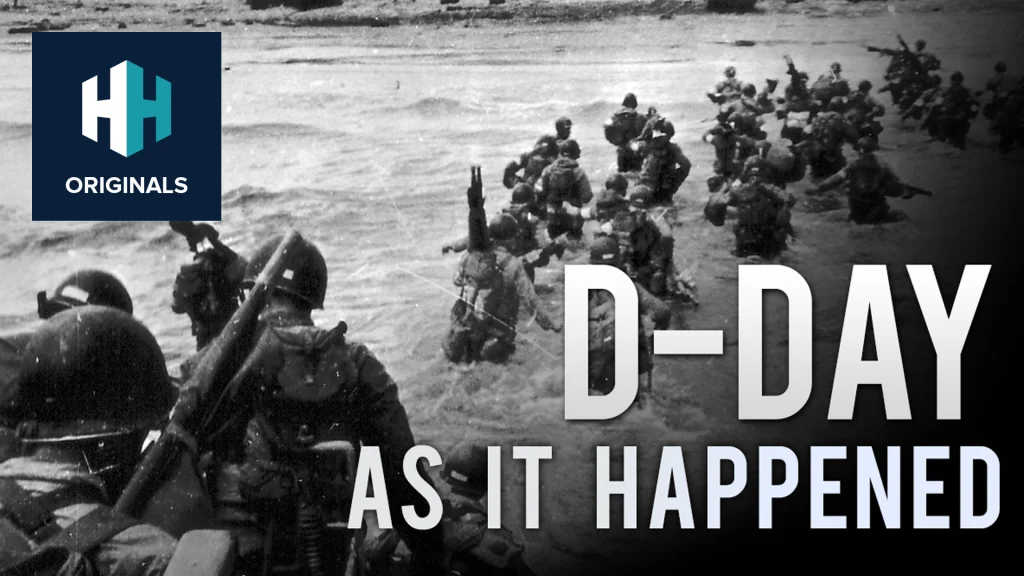Taxis to Hell and Back – Into the Jaws of Death is a photograph taken at around 7.40am on 6 June 1944 by Coastguard Chief Photographers Mate Robert F Sargent.
It is one of the most famous photographs from D-Day and indeed World War Two.
The image sees men of A Company, 16th Infantry Regiment of the US 1st Infantry Division – known affectionately as The Big Red One – wading ashore at Omaha Beach.
 Watch Now
Watch NowFor many, D-Day is remembered chiefly by the bloodshed and sacrifice at Omaha beach. Casualties at Omaha were double that of any other beach.
The details of this image can be used to tell the story of this beach and the men who perished here in the defence of liberty.
1. Low cloud and strong winds

The low cloud, visible near the steep bluffs of Omaha.
6 June brought banks of low cloud over the Normandy coast and strong winds in the Channel.
The troops, packed tightly into landing craft, endured waves up to six feet. Sea sickness was rife. The landing craft would reek of vomit.
2. The lack of armoured support
 Watch Now
Watch NowThe choppy waters also account for a notable absence from this image.
8 tank battalions landing on D-Day were equipped with Duplex Drive or DD tanks. Amphibious tanks belonging to the family of quirky vehicles known as Hobart’s Funnies.
The DD tanks provided invaluable support for the troops landing at Sword, Juno, Gold and Utah.
But at Omaha many of the DD tanks were launched too far from shore in conditions beyond their limitations.
Nearly all of the DD tanks launched at Omaha sank before reaching the beach meaning the men went ashore with no armoured support.
3. The steep bluffs of Omaha beach

At some points these bluffs were over 100 feet high, protected with German machine gun and artillery nests.
Unmistakable in the image are the steep bluffs that characterised Omaha beach.
In January 1944 Logan Scott-Bowden led a reconnaissance mission in a midget submarine to produce a report on the beach.
Delivering his findings to Omar Bradley, Scott-Bowden concluded
“this beach is a very formidable beach indeed and there are bound to be tremendous casualties”.
To capture these heights, American soldiers had to make their way up steep valleys or ’draws’ that were heavily defended by German emplacements. The Pointe du Hoc, for instance, had German artillery pieces installed a’top 100-foot cliffs.
4. Obstacles

The obstacles on Omaha Beach, visible in the distance.
The beach itself is also littered with obstacles. These included steel grills and posts tipped with mines.
Most notable in the image are the hedgehogs; welded steel beams that appear like crosses on the sand. They were designed to stop vehicles and tanks crossing the sand.
With the bridgehead secured, these hedgehogs were broken up and pieces attached to the front of Sherman tanks to create vehicles known as “Rhinos” that were used to create gaps in the notorious hedgerows of the French Bocage countryside.
5. Equipment

The soldiers carry a wide array of equipment.
Facing these terrible odds, soldiers in the photograph are laden with equipment.
To offer some protection, they’re equipped with the standard issue carbon-manganese M1 steel helmet, covered with netting to reduce shine and allow for scrim to be added for camouflage.
Their rifle Is the M1 Garand, in most cases fitted with a 6.7 inch bayonet. Look closely, some of the rifles are wrapped in plastic to keep them dry.

M1 Garand, covered with plastic.
Their ammunition, 30-06 calibre, is stored in an ammo belt around their waist. The handy entrenching tool, or E tool, is strapped to their backs.
Inside their packs, the soldiers carry three-days-worth of rations including tinned meat, chewing gum, cigarettes and a chocolate bar supplied by the Hershey’s Company.
6. The soldiers
According to photographer Robert F. Sargent, the men aboard this landing craft arrived 10 miles off the Normandy coast on the Samuel Chase at 3.15am. They embarked around 5.30am.
The photographer identifies the soldier at the bottom right of the image as Seaman 1st Class Patsy J Papandrea, the bowman tasked with operating the bow ramp.

Seaman 1st Class Patsy J Papandrea.
The man in the centre of the ramp looking left was identified in 1964 as William Carruthers, though this has never been verified.

The soldier believed to be William Carruthers.
7. The sector
Sargent locates the landing craft in Easy Red sector, the largest of ten sectors that made up Omaha, located toward the western end of the beach.

Easy Red Sector was opposed by overlapping German machine gun nests.
The sector included an important ‘draw’ and was defended by four primary defensive positions.
As they hit the beach, these men would have faced high calibre gunfire and overlapping machine gun fire. There would be very little cover for the men in the photograph as they fought their way to the bluffs.
Today, Omaha beach is overlooked by the American Cemetery where almost 10,000 American servicemen killed during D-Day and the wider Normandy Campaign were laid to rest; and where the names are recorded of more than 1500 men, whose bodies were never recovered.















